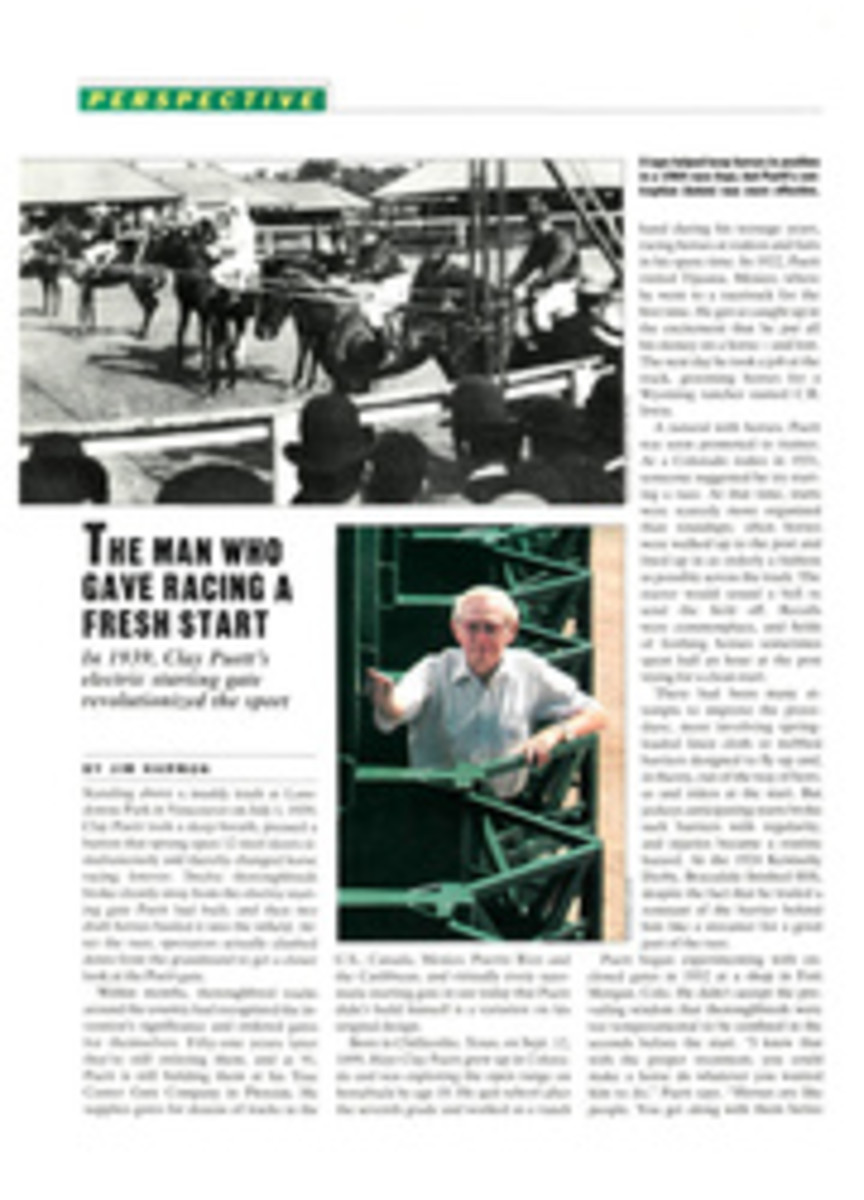
THE MAN WHO GAVE RACING A FRESH START
Standing above a muddy track at Lansdowne Park in Vancouver on July 1, 1939, Clay Puett took a deep breath, pressed a button that sprang open 12 steel doors simultaneously and thereby changed horse racing forever. Twelve thoroughbreds broke cleanly away from the electric starting gate Puett had built, and then two draft horses hauled it into the infield. After the race, spectators actually climbed down from the grandstand to get a closer look at the Puett gate.
Within months, thoroughbred tracks around the country had recognized the invention's significance and ordered gates for themselves. Fifty-one years later they're still ordering them, and at 91, Puett is still building them at his True Center Gate Company in Phoenix. He supplies gates for dozens of tracks in the U.S., Canada, Mexico, Puerto Rico and the Caribbean, and virtually every automatic starting gate in use today that Puett didn't build himself is a variation on his original design.
Born in Chillicothe, Texas, on Sept. 12, 1899, Hoyt Clay Puett grew up in Colorado and was exploring the open range on horseback by age 10. He quit school after the seventh grade and worked as a ranch hand during his teenage years, racing horses at rodeos and fairs in his spare time. In 1922, Puett visited Tijuana, Mexico, where he went to a racetrack for the first time. He got so caught up in the excitement that he put all his money on a horse—and lost. The next day he took a job at the track, grooming horses for a Wyoming rancher named C.B. Irwin.
A natural with horses, Puett was soon promoted to trainer. At a Colorado rodeo in 1931, someone suggested he try starting a race. At that time, starts were scarcely more organized than roundups; often horses were walked up to the post and lined up in as orderly a fashion as possible across the track. The starter would sound a bell to send the field off. Recalls were commonplace, and fields of frothing horses sometimes spent half an hour at the post trying for a clean start.
There had been many attempts to improve the procedure, most involving spring-loaded linen cloth or webbed barriers designed to fly up and, in theory, out of the way of horses and riders at the start. But jockeys anticipating starts broke such barriers with regularity, and injuries became a routine hazard. At the 1924 Kentucky Derby, Bracadale finished fifth, despite the fact that he trailed a remnant of the barrier behind him like a streamer for a good part of the race.
Puett began experimenting with enclosed gates in 1932 at a shop in Fort Morgan, Colo. He didn't accept the prevailing wisdom that thoroughbreds were too temperamental to be confined in the seconds before the start. "I knew that with the proper treatment, you could make a horse do whatever you wanted him to do," Puett says. "Horses are like people. You get along with them better with kindness than with anything else."
Puett's first lever-operated partition gate had chains across the horses' breasts as barriers. He took it to the 1932 Colorado State Fair in Pueblo and asked the officials if he could start a race with it. No, Puett was told, he couldn't, but if he showed the fair's hired starter how the gate worked, the starter would give it a try in the first race.
"I guess the man didn't have too much experience," Puett recalls, chuckling. When the horses had been walked into their stalls and just as the starter was about to pull the lever, he inexplicably yelled to the jockeys, "Are you ready?" Reacting instantly, the riders kicked and their mounts lunged into the chains, nearly tipping the gate over and sending jockeys sprawling. "You've never seen such a mess," Puett says. "Jockeys were on the ground, horses were everywhere. It was comical; the crowd was laughing."
Luckily, no jockeys or horses were hurt, and the field regrouped and made a reasonable start from the gate, this time with Puett manning the lever. But Puett could see that he still hadn't hit upon the right design. Chains would only encourage horses to attempt to escape under or over them. He needed doors that would reach from a horse's head to its knees. Puett tinkered with blueprints and gate parts at a machine shop in Los Angeles, where he spent his winters. In the summers he headed to Vancouver, where he had been hired to start races at Lansdowne and Hastings parks.
By 1939, Puett had come up with a design that he was sure would work. He took on three well-heeled partners and opened the Puett Electrical Starting Gate Corporation in Beverly Hills. His new gate had doors that came together in a V, which would give the stall occupants some headroom, keep them calm and align them properly for the start. An engineer who knew one of the partners had designed solenoid latches similar to the ones used on Army Air Corps bomber doors, a large number of which could be tripped simultaneously with current from a 12-volt battery. The tension of steel springs swung the doors open in a fraction of a second.
Puett invited a dozen racing officials to a demonstration at Hollywood Park in the spring of 1939, and two horses broke cleanly from closed stalls. While the officials were impressed, they were concerned about possible mechanical breakdowns. Finally, Sam Randall, Lansdowne Park's owner, gave Puett permission to start a 5½-furlong race with a 12-stall gate on the opening day of the 1939 summer season. After Puett pushed the button and the horses broke like a team, his order book filled up fast.
The first electric start in the U.S. took place at Bay Meadows in San Mateo, Calif., in the fall of 1939, and Puett shipped a gate east to be displayed at Pimlico. In 1940 the Preakness Stakes became the first Triple Crown event to use one of his gates. The next year he was granted a patent for his V door design. Churchill Downs ordered a 14-stall Puett model, which was used to start the 1941 Kentucky Derby and the next 36 as well.
Puett could have become a wealthy man, but he says, "I was so green that I should have been planted and watered." As the demand for his gates increased in the 1940s, he traveled thousands of miles a year, delivering gates, maintaining gates and trailering them from track to track. He was on the road for months at a time. Back in Beverly Hills, his partners, bound by nothing more than a handshake, were working to take the company in a different direction. They voted down his plan to build a new manufacturing plant and refinanced the company without his knowledge.
In 1946, Puett agreed to sell his share of Puett Electrical Starting Gate Corporation to his partners for a remarkably modest sum. "They took advantage of me, but I let them," Puett says. "I figured $31,000 was all the money I needed." Puett, then 47, planned to retire to a life of fishing and breeding thoroughbreds on a ranch that he had bought near Kamloops, B.C.
Within two years Puett had had his fill of retirement. He returned to the Southwest in search of work. He tried to get back into the gate business and found himself competing with the company bearing his name. He's still competing with it. Over the years, ownership has been transferred several times and now Puett Electrical Starting Gate Inc. has merged with United Starting Gate Corp., based in South Salem, N.Y., to form United/Puett Electrical Starting Gate Corp. It controls more than half the starting-gate market in the U.S.
In 1953, Puett founded True Center (named for the horse-straightening effect of his patented V doors) in British Columbia. He moved the operation to Phoenix in 1955. Since then Puett has been the supplier for as many as 48 tracks at a time. In addition to building new gates, he keeps an inventory of more than 30 that are available for lease. The models range in capacity from two and three stalls—for training colts and fillies—up to 14. The big ones are 64 feet long, take 800 man-hours to assemble, require a special towing permit on certain highways and sell for $100,000 or more.
Besides building an estimated 200 gates over the years, Puett has worked as a racing official in Vancouver, Calgary, Edmonton, Seattle, San Bruno, Calif., Phoenix, Denver and Cleveland. The Arizona Horse Racing Hall of Fame inducted him in 1964, and the British Columbia Thoroughbred Breeders' Society voted him into its hall of fame in 1980.
Puett knows that his life would have been different if he had had more business savvy, but he's not sure it would have been better. And he admits to a measure of satisfaction in having outlived all of his former business partners. "I'm the one," says Puett, "who's still around."
PHOTO
THE BLOOD-HORSE MAGAZINE
A tape helped keep horses in position in a 1904 race (top), but Puett's contraption (below) was more effective.
PHOTO
SCOTT ROBINSON
[See caption above.]
Jim Harmon, who lives in Hermosa Beach, Calif., has written several stories for SI.

